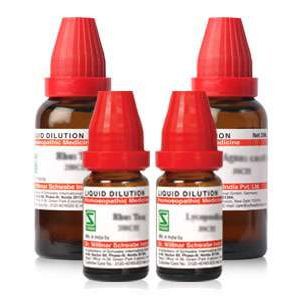Doctors Zone
Journal (JEBH)
Alpha™- Liv Drops
Alpha – Liv Drops Due to high demand from the market, for a formulation in drops for the liver, apart from the syrup already available in the market, Schwabe India developed this product. Introduction The liver plays a key role in metabolism. It has anabolic and catabolic, exocrine and endocrine functions. The liver is a blood reservoir, filter and store of different substances (e.g. glycogen, vitamins). It is the site of serum protein (e.g. albumin, prothrombin, fibrinogen) and enzyme synthesis. Metabolic processes (e.g. bilirubin, hormone, carbohydrate and lipid turnover) and the removal of toxic products are important liver functions. 1 Hepatotoxins (e.g. alcohol, tetracycline, acetaminophen, fungal toxins, and anabolic steroids) can cause specific damage to liver cells. Toxic hepatitis may be clinically silent or severe enough to lead to the rapid development of hepatic failure. Clinical features include hepatomegaly, enzyme abnormalities, fever, abdominal pain, anorexia, nausea, vomiting and weight loss. In patients with underlying cirrhosis, manifestations of portal hypertension may predominate. Aversion to fatty food, abdominal discomfort, nausea and vomiting after meals may be symptoms of 2 cholelithiasis. Jaundice results from accumulation of bilirubin. It has non-hepatic as well as hepatic causes. Hyperbilirubinaemia may be due to abnormalities in the 3 formation, transport, metabolism or excretion of bilirubin. TM Alpha -Liv Drops aids recovery and normalisation of liver functions. Severe liver disease needs specialised treatment. Indications: Slow liver functions, fatty liver, and for supportive treatment of hepatocellular jaundice and toxic liver damage.

Homoeopathic Management of Diabetes by Vaccinium Myrtillus – Schwabe News
Homoeopathic management of diabetes by Vaccinium myrtillus
Recently a study has been done to define this therapeutic action by administering Vaccinium myrtillus orally to streptozotocin induced diabetic rats for 4 days. It has been witnessed that plasma glucose consistently dropped by 26% at two differently stages of diabetes. Plasma triglyceride (TG) were also reduced by 39%. Subsequent to the latter observation, possible lipid-lowering properties of the extract were investigated on other models of hyperlipidaemia and ciprofibrate, a well-established hypolipidaemic drug, was used as a reference compound. Both drug reduced TG levels of rats on hyperlipidaemic diet in a dose-dependent fashion. When administered at single doses over the same experimental period, Vaccinium myrtillus and ciprofibrate were effective in lowering TG concentrations in ethanol-treated normolipidaemic animals and in genetically hyperlipidaemic Yoshida rats. Unlike ciprofibrate, however, this drug failed to prevent the rise in plasma TG elicited by fructose and did not affect free fatty acid levels in any of the above experimental conditions. In rats treated with Triton WR-1339, blueberry feeding induced an hypolipidaemic activity one hour after injection but proved to be ineffective at later time points, thus suggesting that its hypolipidaemic action may reflect improved TG-rich lipoprotein catabolism. In addition, ciprofibrate and this drug were tested for antithrombotic activity using a collagen-triggered model of venous thrombosis in diabetic and Yoshida rats. Only ciprofibrate, however, significantly reduced thrombus formation in diabetics, possibly because of its effects on free fatty acid metabolism, whereas no effect was observed in Yoshida rats. In conclusion, the present findings indicate that Vaccinium myrtillus may prove potentially useful for treatment of diabetes, dyslipidaemiae associated with impaired TG-rich lipoprotein clearance.
Reference:
Andrea Cignarella, Milena Nastasi, Elena Cavalli, Lina Puglisi, Novel lipid-lowering properties of vaccinium myrtillus l. Leaves, a traditional antidiabetic treatment, in several models of rat dyslipidaemia: A comparison with ciprofibrate, Thrombosis Research, Volume 84, Issue 5, 1 December 1996, Pages 311-322
Recent Advancements in Basic Homeopathic Research – A Report on Two Significant Publication
In a study conducted at the Experimental Farm of the State University of Santa Catarina, Brazil, researchers investigated the impact of homeopathic treatments on piglets during the nursery phase. The study aimed to determine whether homeopathic agents could reduce fighting behavior, improve growth performance, and affect hematological, metabolic, and oxidative variables. The study included 108 weaned piglets divided into four groups: a negative control group receiving only the basal diet, and three groups receiving different homeopathic treatments at varying dosages.
Journal of Evidence Based Homeopathy Volume: 1, Issue: 1, January - June 2023
Comprehensive articles

Agrohomeopathy – A Review
Short cases

Unmasking the Intricacies: A Pyogenic Abscess Case Report

Lichen Simplex: A Singular Case Study

Ranula Unveiled: A Case Report and Management Approach

Lichen Simplex: A Singular Case Study

A Puzzling Presentation: A Case Report of Jaundice
Recent provings and updated materia medica

Acidum Formicum

Mygale

Thea Chinensis
Materia medica on phytohomeopathy

Chrysarobinum

Sanguinarinum nitricum

Thiosinaminum
Mother tincture

Asparagus Officinalis

Ginkgo Biloba

Rosmarinus Officinalis
Product watch

Alpha™- Liv Drops

Good Morning™ Constipation Drops

Zauber™ Hair Drops
Research News

























